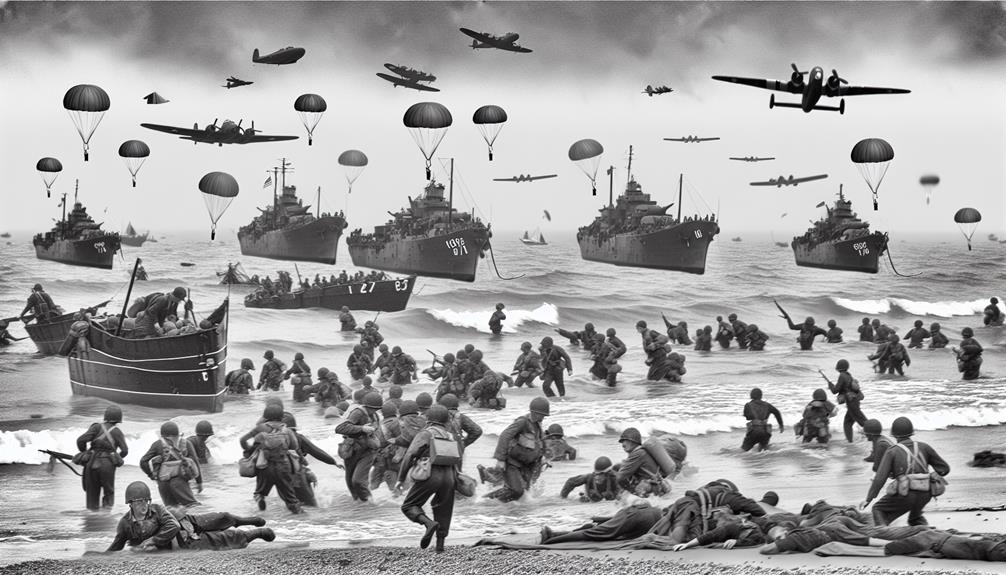The events of D-Day at Normandy stand as a testament to meticulous planning and unwavering determination in the face of considerable odds. The Allied invasion, often described as a defining moment in World War II, unfolded with calculated precision and unanticipated challenges. As history unfolded on the shores of Normandy, the world witnessed the convergence of strategy, valor, and sacrifice on an unprecedented scale. Yet, beneath the surface of this well-known narrative lies a web of complexities and human stories waiting to be unraveled, shedding light on the intricate tapestry of this pivotal moment in history.
Key Takeaways
- Strategic planning by Allied leaders for Normandy invasion.
- Largest amphibious assault in history during Operation Neptune.
- Overcoming German defenses on well-fortified Normandy beaches.
- Significance in defeating Nazi Germany and symbolizing Allied determination.
- Annual commemorations honoring bravery and sacrifices of D-Day.
Origins of the D-Day Operation
The origins of the D-Day Operation can be traced back to the strategic planning and coordination efforts of Allied military leaders in response to the need for a decisive invasion of Nazi-occupied Western Europe during World War II. Central to the success of the operation was the gathering of preparatory intelligence, which involved meticulous analysis of enemy defenses, coastal conditions, and potential landing sites. This intelligence-gathering phase was vital in shaping the overall strategy and determining the timing and location of the invasion.
In addition to preparatory intelligence, Allied forces faced significant logistical challenges in preparing for the D-Day landings. The scale of the operation required a massive undertaking in terms of troop deployment, equipment transport, and supply chain management. To overcome these challenges, Allied planners had to coordinate the efforts of multiple military branches, ensure the secrecy of the operation, and navigate the complex waters of inter-Allied cooperation.
The success of the D-Day Operation hinged on the ability of Allied leaders to effectively address these preparatory intelligence and logistical challenges. Through careful planning, strategic coordination, and unwavering determination, the Allies were able to launch a coordinated amphibious assault on the beaches of Normandy on June 6, 1944. This marked a turning point in World War II and ultimately paved the way for the liberation of Western Europe from Nazi occupation.
Allied Forces Preparation and Training
Amidst the meticulous planning and logistical challenges leading up to the D-Day Operation, Allied forces undertook extensive preparation and training to guarantee the success of the impending amphibious assault on the beaches of Normandy in 1944. Troop morale was a focal point during this phase, as commanders recognized its pivotal role in the soldiers' readiness and performance on the battlefield. To boost morale, various initiatives were implemented, including recreational activities, religious services, and letters from home, all aimed at maintaining a positive mindset among the troops amidst the looming mission.
However, despite the emphasis on morale, Allied forces faced significant equipment shortages during their preparation. The demands of equipping a massive invasion force, coupled with the challenges of wartime production, led to shortages in essential supplies and equipment. This posed a serious challenge to the training process, as soldiers had to adapt to using substitute materials and equipment, impacting the realism and effectiveness of their training exercises.
To counter these shortages, innovative solutions were devised, such as improvising with mock equipment and intensifying training on essential skills to compensate for the lack of resources. Despite the obstacles posed by equipment shortages, Allied forces persevered, demonstrating resilience and adaptability in their preparation for the pivotal D-Day invasion.
The Strategic Importance of Normandy
Strategically positioned along the northern coast of France, Normandy emerged as a pivotal focal point in the Allied strategy during World War II. The strategic significance of Normandy lay in its geographic location, which offered a gateway to Western Europe. By securing Normandy, the Allies gained an essential foothold from which to launch further offensives against Nazi-occupied territory.
| Strategic Significance of Normandy | Military Tactics |
|---|---|
| Proximity to England allowed for swift reinforcement and supply lines | Implementation of amphibious landings for swift and decisive attacks |
| Varied coastline provided options for choosing landing sites | Deployment of airborne troops behind enemy lines to disrupt German defenses |
| Possession of vital ports facilitated the unloading of troops and supplies | Establishment of artificial harbors (Mulberry harbors) to ensure logistical support |
The military tactics employed in the Normandy campaign were innovative and instrumental in achieving success. The Allies capitalized on the element of surprise by utilizing diversionary tactics and deceptive measures to mislead German forces about the actual location of the invasion. Additionally, the careful coordination of ground, naval, and air forces showcased the Allies' ability to execute large-scale joint operations effectively.
The D-Day Invasion Plan Unfolds
Unfolding with meticulous planning and coordinated precision, the D-Day invasion plan marked a pivotal moment in Allied military strategy during World War II. The success of the invasion hinged on a series of key elements that were executed flawlessly:
- Strategic Deception: Operation Bodyguard, a massive deception campaign, misled the Germans about the actual location and date of the invasion. This misinformation was essential in keeping the German forces off-guard and uncertain about the Allies' true intentions.
- Airborne Assault: In the early hours of June 6, 1944, thousands of paratroopers from the U.S. 82nd and 101st Airborne Divisions were dropped behind enemy lines to secure key objectives and disrupt German defenses. This airborne assault played a critical role in securing the flanks of the invasion beaches.
- Tactical Maneuvers: The Allied forces employed sophisticated tactics, including amphibious assaults, to establish a foothold on the Normandy coast. Specialized units were tasked with clearing beach obstacles, neutralizing enemy strongpoints, and securing beachheads for the incoming troops.
- Naval Bombardment: Prior to the amphibious landings, a massive naval bombardment pounded the German coastal defenses, targeting key fortifications and artillery positions. This intensive shelling softened enemy positions and provided cover for the approaching landing craft.
The meticulous coordination of these elements, combined with the bravery and determination of the Allied troops, culminated in the successful execution of the D-Day invasion plan, setting the stage for the liberation of Western Europe from Nazi occupation.
The Assault on the Normandy Beaches
The Allied assault on the Normandy beaches on June 6, 1944, marked a pivotal moment in World War II, showcasing meticulous planning and coordinated execution. This operation, codenamed Operation Neptune, involved the largest amphibious assault in history, with thousands of troops landing on five beaches along the Normandy coast: Utah, Omaha, Gold, Juno, and Sword.
As the Allied forces approached the French coast, they faced formidable beachhead defenses set up by the German troops. The Germans had constructed bunkers, obstacles, and mined areas to repel any invasion. Despite the challenges, the Allied troops, consisting of American, British, Canadian, and other forces, launched a massive amphibious assault, landing on the beaches under heavy fire.
The success of the assault hinged on overcoming the well-prepared German defenses. The troops had to quickly establish beachheads to secure a foothold and expand their presence inland. Through sheer determination and courage, the Allied forces were able to break through the German defenses, albeit at a significant cost in terms of lives lost.
The amphibious assault on the Normandy beaches not only demonstrated the Allied forces' military prowess but also highlighted their ability to adapt to unforeseen circumstances. The meticulous planning and coordinated execution of the operation set the stage for the liberation of Western Europe from Nazi occupation.
Challenges and Obstacles Faced
Amidst the intense Allied assault on the Normandy beaches, the formidable challenges and obstacles faced by the troops posed significant hurdles to establishing a successful beachhead. The logistical challenges and tactical maneuvers required to overcome these obstacles were immense, shaping the course of the invasion.
Here are the key challenges faced during the D-Day landings:
- Enemy Defenses: German forces had heavily fortified the coast, with obstacles like beach obstacles, mines, and bunkers, creating deadly barriers for the Allied troops to breach.
- Weather Conditions: Unpredictable weather on D-Day caused rough seas and low visibility, leading to challenges in navigation, coordination, and landing accuracy.
- Communication Breakdowns: The chaos of battle and the vast scale of the operation led to communication failures between troops, impacting coordination and decision-making.
- Limited Resources: Despite extensive planning, shortages in critical supplies like ammunition, fuel, and reinforcements hampered the troops' ability to sustain momentum and expand their foothold.
Each of these challenges demanded quick thinking, adaptability, and courage from the Allied forces as they fought to secure the beaches and push inland. Overcoming these obstacles required a blend of strategic planning, resilience, and the ability to improvise under immense pressure.
Breakthrough and Liberation
Maneuvering through the chaos of battle and the remnants of enemy defenses, the Allied forces strategically orchestrated breakthroughs that marked the beginning of liberation during the Allied Invasion of WWII. These breakthrough successes were pivotal moments that showcased the Allied triumph over the Axis powers in Normandy.
The Allied forces, comprising troops from various nations united in a common goal, exhibited exceptional coordination and determination during the breakthrough phase. Their meticulous planning and execution allowed them to penetrate deep into enemy territory, dismantling fortified German positions and pushing the frontline further inland. Through a combination of infantry assaults, armored thrusts, and aerial support, the Allies were able to gain significant ground and secure key objectives.
One of the most notable breakthrough successes during the Allied Invasion was the capture of strategic towns and bridges, which facilitated the rapid advancement of Allied troops. These victories not only disrupted German supply lines but also boosted the morale of the Allied forces, instilling a sense of confidence and momentum that would carry them through the subsequent phases of the campaign.
As the Allied forces continued to press forward, each successful breakthrough brought them closer to the ultimate goal of liberating occupied territories and restoring freedom to those under German oppression. The Allied triumph in Normandy was a reflection of their unwavering dedication, courage, and unity in the face of adversity.
Securing the Beachhead
Securing a foothold on the heavily fortified beaches posed a formidable challenge for the Allied forces during the initial phase of the invasion. The beach defenses set up by German troops were designed to repel any amphibious assault, making the task even more challenging for the Allies. Despite these obstacles, the Allied forces displayed remarkable courage and strategic prowess in overcoming the entrenched German positions.
Here are some key aspects of the efforts to secure the beachhead:
- Coordination and Planning: Extensive planning and coordination were essential for the success of the amphibious assault. The Allies meticulously studied the beach defenses, identified weak points, and formulated strategies to breach enemy lines.
- Overcoming Resistance: The German defenders put up fierce resistance, utilizing machine guns, artillery, and obstacles such as mines and beach obstacles. The Allied troops had to navigate through this deadly maze under heavy fire to establish a foothold on the beaches.
- Air and Naval Support: Close air support from Allied aircraft and naval bombardment played a significant role in softening enemy defenses and providing cover for the troops landing on the beaches. This support was instrumental in neutralizing German positions and reducing casualties among the assaulting forces.
- Adaptability and Tenacity: The Allied forces demonstrated remarkable adaptability and tenacity in the face of adversity. Despite facing strong opposition, they pushed forward, gradually expanding the beachhead and paving the way for the next phase of the operation.
Advancing Inland: Battle for Normandy
The successful establishment of the beachhead marked the beginning of a new phase in the Allied invasion of Normandy as they now faced the challenging task of advancing inland amidst the heavily fortified German defenses. The inland skirmishes that ensued were characterized by intense fighting as the Allies pushed further into enemy territory. The Allied strategy focused on exploiting weaknesses in the German defenses, utilizing air support, and coordinating ground forces to gain strategic positions.
Despite the German resistance, the Normandy progress was steady but arduous. The Germans had constructed a formidable defense network, including bunkers, minefields, and fortified positions, making every mile gained by the Allies hard-fought and costly. The Allies had to adapt quickly to the changing battlefield conditions, often resorting to innovative tactics to overcome German strongholds.
As the Allied forces advanced, they encountered fierce German counterattacks aimed at halting their progress. The battles in the hedgerows of Normandy were particularly brutal, with both sides sustaining heavy casualties. The Allied commanders had to make tough decisions on the fly, adjusting their tactics to break through German lines while minimizing losses.
Legacy of D-Day
With a profound impact on military strategy and historical memory, the Allied invasion of Normandy, known as D-Day, left a lasting legacy that reverberates through the annals of World War II. The legacy of D-Day extends far beyond the events of June 6, 1944, shaping the post-war world in numerous ways:
- Post-war Reconciliation:
D-Day marked a pivotal moment in the defeat of Nazi Germany, leading to the liberation of Western Europe. The cooperation and unity among Allied forces during the invasion laid the foundation for post-war reconciliation efforts. The shared sacrifice and common goal of defeating a common enemy fostered a sense of camaraderie among nations that endured beyond the war.
- Commemorative Events:
The legacy of D-Day is upheld through annual commemorative events that honor the bravery and sacrifice of those who participated in the invasion. Ceremonies, memorials, and gatherings serve as reminders of the courage displayed on the beaches of Normandy and guarantee that the memory of D-Day lives on for future generations.
- Historical Significance:
D-Day remains a symbol of Allied cooperation and determination in the face of adversity. The successful invasion not only turned the tide of the war but also demonstrated the power of unity and strategic planning in overcoming seemingly insurmountable challenges.
- Educational Impact:
The legacy of D-Day continues to educate future generations about the sacrifices made during World War II. Through historical accounts, documentaries, and educational programs, the significance of D-Day is preserved, safeguarding that the lessons learned from this critical moment in history are not forgotten.
Frequently Asked Questions
How Did Weather Conditions Impact the Success of the D-Day Operation?
Weather challenges played a significant role in shaping the outcome of the strategic decisions made during the D-Day operation. The unpredictable nature of weather conditions, such as strong winds and rough seas, affected the timing and execution of the invasion plans. These challenges forced military leaders to adapt quickly, leading to pivotal decisions that influenced the success of the operation.
Understanding and managing these weather-related obstacles were essential in achieving the desired outcomes.
What Role Did Intelligence Operations Play in Planning the Normandy Invasion?
In the intricate planning of the Normandy invasion, intelligence operations played a pivotal role. The success of codebreaking efforts provided invaluable insights into enemy movements, while strategic deception tactics misled German forces.
Double agents and reconnaissance missions supplied critical information on enemy positions and defensive strategies. The meticulous coordination of these intelligence operations was essential in shaping the outcome of the invasion and ensuring the Allied forces' success on D-Day.
Were There Any Significant Civilian Contributions to the D-Day Effort?
Civilian support during the D-Day effort was significant, with resistance movements playing a pivotal role in intelligence gathering, sabotage, and logistical support. Local civilians provided valuable knowledge of the terrain and enemy activities, aiding Allied forces in planning and execution.
Resistance fighters conducted acts of sabotage behind enemy lines, disrupting German communications and transportation networks. Their contributions were instrumental in the success of the Normandy invasion.
How Did the Allied Forces Handle Casualties During the Normandy Invasion?
During the Normandy invasion, the Allied forces implemented a sophisticated system for handling casualties. Medical care was provided through onsite field hospitals, where injured soldiers received immediate treatment.
Triage was vital in prioritizing cases based on severity, ensuring those in critical condition were evacuated swiftly for advanced care. This efficient system minimized fatalities and enabled the Allies to maintain combat effectiveness despite the challenges of the battlefield.
What Diplomatic Negotiations Took Place Leading up to D-Day?
Prior to D-Day, diplomatic negotiations were essential in forming alliances and planning strategic discussions. Political negotiations and international agreements were crucial in coordinating the efforts of various nations involved in the invasion.
Diplomatic ties were strengthened through careful deliberations and agreements, ensuring a united front against the Axis powers. These negotiations played a significant role in shaping the course of the Allied invasion and ultimately led to the success of D-Day.
Conclusion
In the tapestry of World War II, the Allied invasion of Normandy stands as a shining thread of unity, courage, and perseverance.
Like a symphony of strategic maneuvers and tactical brilliance, D-Day at Normandy orchestrated a harmonious victory that reverberates through history.
The legacy of this pivotal moment serves as a beacon of hope and inspiration, reminding us of the power of collaboration, determination, and sacrifice in the face of adversity.


